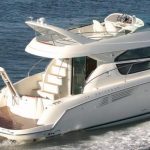Cummins Marine Diesel Repower Specialists › Forums › Cummins Marine Engines › Benefits of Freshwater Flushing
- This topic has 20 replies, 9 voices, and was last updated 5 years ago by
 Javier.
Javier.
-
CreatorTopic
-
October 27, 2018 at 2:02 pm #38983
In the last while, there has been some discussion on the forum where the benefits of freshwater flushing have been debated. I am no expert and often seek help from the contributors here, but now, I am a big believer in freshwater flushing.
This fall, I have undertaken some maintenance on my engine, including replacing the idler pulley, refurbishing the alternator, removing the fuel cooler, and doing the aftercooler.
It has been 2 full summer cruising seasons and about 350-400 engine hours since the raw water cooling system was serviced. At that time, the aftercooler looked to be relatively new. The mechanic I used (I had an exhaust hose overheat that I was trying to solve), didn’t reassemble the aftercooler to Seaboard’s specs (he did use a small amount of grease), so I wanted to take it apart to ensure it stays in good shape. The engine has been freshwater flushed as often as I could (but certainly not after every use as some marinas don’t have water to spare and we anchor alot) and was stored over the winter with a solution of “salt away” in it.
I have attached some photos of the cooler right after I took it apart. It looked great, with no corrosion at all!
I examined the gear cooler, and it looks just as good.
I will continue to freshwater flush as often as I can. To me, it appears to definitely be worth it!
Regards,
Tom -
CreatorTopic
-
AuthorReplies
-
January 17, 2019 at 2:50 pm #54297

JavierParticipantVessel Name: GUANCHITO
Engines: Cummins QSB 5.9 425CV
Location: España
Country: España
Otro tipo de toma agua de puerto
Buenas os pongo alguna foto del sistema de enjuague que monté en los motores.
SaludosJanuary 12, 2019 at 2:15 pm #53407
DeWayne EnyeartParticipantVessel Name: Buster
Engines: Cummins 6BT5.9-M
Location: Olympia, WA
Country: USA
Emergency dewatering system
The primary reason for my modification of the sea water cooling system was for fresh water flushing. I neglected to mention that this modification could also be used for emergency vessel dewatering.
December 18, 2018 at 6:56 am #50474
Rob SchepisForum ModeratorVessel Name: Tenacious
Engines: 6BTA 5.9 330's - "Seaboard Style"
Location: Long Island, NY
Country: USA
All is good. Wow, at 800rpms I think I would take the dock for a ride! (or atleast a part of it…)
December 17, 2018 at 11:22 pm #50468
DeWayne EnyeartParticipantVessel Name: Buster
Engines: Cummins 6BT5.9-M
Location: Olympia, WA
Country: USA
Why run engine under load?
Rob:
Short answer: habit
You are correct that the engine was not cold before the freshwater flush. It has been my practice not to run the engine without a load. The engine was in forward gear @800 RPMs for the flush procedure. I do not have data to support my habit as a “Best Practice.”December 16, 2018 at 7:08 pm #50280
Rob SchepisForum ModeratorVessel Name: Tenacious
Engines: 6BTA 5.9 330's - "Seaboard Style"
Location: Long Island, NY
Country: USA
Nicely done and thank you for the detailed write up and photos, that will surely help others. Why do you run the engine under load? Isn’t the flush performed after you come back in so the engine should be at operating temperature or close to it, she’s certainly not cold?
December 16, 2018 at 4:17 pm #50274
Tony AthensModeratorVessel Name: Local Banks
Engines: QSB 6.7 550 HP
Location: Oxnard, CA
Country: USA
You thought it out well as to how you could do it, and then you went for it………………… Works for you and if are diligent about over the years to come, the results are well worth the effort..
Good job!
Tony
December 15, 2018 at 10:09 pm #50235
DeWayne EnyeartParticipantVessel Name: Buster
Engines: Cummins 6BT5.9-M
Location: Olympia, WA
Country: USA
Another version of a freshwater flush system
The attached photos show the freshwater flush system that has been installed on my trawler.
1. Seawater inlet valve closed; freshwater inlet valve open
2. A close up shot of #1
3. Freshwater inlet valve closed; seawater inlet valve open following the freshwater flush
4. Freshwater supply hose coiled in bilge
Supply list:
1. T-fitting
2. Reduction bushing
3. Ball valve
4. Hose barb
5. 3/4″ reinforced potable water hose
6. 5 gallon bucket
Freshwater flush procedure:
1. Engine running under load in slip
2. Place 5 gallon bucket in cockpit
3. Connect garden hose to dockside water bib
4. Place other end of garden hose into bucket
5. Turn dockside water full ON
6. Place end of red hose into bucket
7. When bucket is full of water, open freshwater inlet valve.
8. Close seawater inlet valve
9. Flush for 5″
10. Turn dockside water supply OFF
11. Turn engine OFF
12. Close freshwater inlet valve
13. Open seawater inlet valve
14. Coil red hose and place in the bilge
The combination of a 3/4″ garden hose and the dockside water pressure keeps the bucket full during the flush process. The red hose does not collapse during the flush process. The bucket is about half full of water when the engine is shut off.December 13, 2018 at 9:22 am #49547Mike,
If your exhaust in “inherently safe” as to water flow to the exhaust exit into the ocean, then you would not even have to start the engine to do it this way or shut the seacock if hooked up the the OUTPUT port on the pump..
Let’s “see’ what you have between the MIXER and the exhaust exit. Pics and an elevation sketch in relation to the LWL sitting at the dock.
Tony
Well, I have a lift muffler so I’ll have to run to flush. Can I run it with the seacock closed but with a garden hose running to the output port of the pump?
December 13, 2018 at 6:04 am #49526
Tony AthensModeratorVessel Name: Local Banks
Engines: QSB 6.7 550 HP
Location: Oxnard, CA
Country: USA
Fresh water flushing
Mike,
If your exhaust in “inherently safe” as to water flow to the exhaust exit into the ocean, then you would not even have to start the engine to do it this way or shut the seacock if hooked up the the OUTPUT port on the pump..
Let’s “see’ what you have between the MIXER and the exhaust exit. Pics and an elevation sketch in relation to the LWL sitting at the dock.
Tony
December 12, 2018 at 5:24 pm #49511Hi Mike,
I have seen several (and heard about many more) boats that have a similar sea strainer setup as mine. I don’t think there is much risk of doing permanent damage to the lid, especially if you have a shop do the work.
As far as water flow, I have an Aqualarm water flow alarm installed between my strainer and the SMX pump. When I am running with the through hull closed and only the garden hose on, this alarm sounds. However, the pump stays cool (have held my hand on it for a complete flush) and I am getting enough water to lube the impeller. I only run like this for a few minutes. If the perceived lack of water scares you, just leave the through hull partially open. It will still “flush” and be much better than leaving the system full of straight salt water.
It is best to use a good quality garden hose, as the engine will partially collapse a “soft pliable” hose.
You can try other methods, but this one is inexpensive (equipment and setup wise), and only takes about 10 minutes (or less) for the whole process.
As stated earlier, there are other methods, but his one works and is very easy.
Good luck,
TomDecember 12, 2018 at 11:58 am #49356Rather than tapping the lid, what would be the disadvantage of simply connecting a valve and fresh water (hose) line to the output port on the SMX water pump? With the seacock closed, would the water supply at this port keep the impeller sufficiently wet to avoid damage? Would there be any issues… maybe related to the vacuum created due to the closed seacock and small water supply at the garden hose? I feel like this could be the best method because it would avoid messing with the structural integrity of the strainer lids…
December 12, 2018 at 5:31 am #49333
Rob SchepisForum ModeratorVessel Name: Tenacious
Engines: 6BTA 5.9 330's - "Seaboard Style"
Location: Long Island, NY
Country: USA
If you don’t already own the proper tap and drill bit probably best to just pay to get it done. But if you’d rather invest in the tools and DIY then McMaster Carr has what you need – the drill bit, the tap and the fittings.
December 11, 2018 at 8:11 pm #49318
Tony AthensModeratorVessel Name: Local Banks
Engines: QSB 6.7 550 HP
Location: Oxnard, CA
Country: USA
If you cannot do it in-house, then you can send them to us or a shop that knows what you need,
Maybe an hour of shop time for 2 lids , $25-30 in materials, and some return shipping. We typical install a brass garden hose connection or 3/4″ barb as we think that is the easiest to work with.
Tony
December 11, 2018 at 10:29 am #49165How do you go about tapping the lid with a hole that big? Machine shop?
December 10, 2018 at 10:23 am #48775My Set Up for Flushing
Hi Finalee,
My freshwater flush setup is quite simple but effective, however, the engine must be running. There is an attachment point for a “standard garden hose” on the lid of my raw water (Groco) strainer. I just attach a dock water line to this attachment, open the through hull, turn on the freshwater, and start the engine. Then close or partially close the through hull and run the engine at idle for a few minutes. Shut down the engine and the freshwater at the same time (or water slightly ahead of engine shutdown) and you are done other than putting the hose away. As Tony stated, there are other ways to do this, but my boat came setup like this when I bought her.
Hope that helps,
TomDecember 10, 2018 at 7:21 am #48716
Tony AthensModeratorVessel Name: Local Banks
Engines: QSB 6.7 550 HP
Location: Oxnard, CA
Country: USA
Fresh water flushing
Go to “search” Just type flushing . Maybe 60+ various posts and ideas on the subject.
How you do it is not engine type specific… It’s more a an how your engine is installed and plumbed specific..
Tony
December 10, 2018 at 3:50 am #48700
RiggersandFinsBdaParticipantHello Tony, where can I find a good instsl ‘how-to’ for a flush system for a 6CTA M2, cpl1929
December 3, 2018 at 2:31 pm #47706Same results here. We FWF eveytime the boat is used. Takes 5 minutes and results are well worth the time. No brainer.
December 2, 2018 at 11:07 pm #47485
David R FlamerParticipantVessel Name: Tax Break
Engines: QSB5.9 380
Location: Marina del Rey/Channel Islands Harbor, CA
Zincs after one year with fresh water flushing
I’ve been trying to fresh water flush after every single run. I have just changed the zincs on both engines and was surprised to see that they were in pretty good shape. They were in the engines about one year.
Picture is attached.
October 27, 2018 at 3:18 pm #38989
Tony AthensModeratorVessel Name: Local Banks
Engines: QSB 6.7 550 HP
Location: Oxnard, CA
Country: USA
All I can say is that anyone that thinks FRESH WATER FLUSHING will not pay major dividends over 10-20 years has no clue……….. IMO, more than worth the effort if you have the time vs. the $$ it will cost if you don’t do it..
Thanks for sharing..
Tony
-
AuthorReplies
You must be logged in to reply to this topic.
